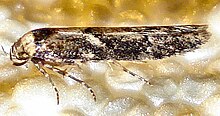Blastobasidae
| Blastobasidae | |
|---|---|
 |
|
| Adult Blastobasis adustella from Lincolnshire (UK) |
|
| Scientific classification | |
| Kingdom: | Animalia |
| Phylum: | Arthropoda |
| Class: | Insecta |
| Order: | Lepidoptera |
| Superfamily: | Gelechioidea |
| Family: |
Blastobasidae (disputed) Meyrick, 1894 |
| Diversity | |
| About 24 genera and 377 species | |
| Synonyms | |
|
|
The Blastobasidae are a family of moths in the superfamily Gelechioidea. Its species can be found almost anywhere in the world, though in some places they are not native but introduced by humans. In some arrangements, these moths are included in the case-bearer family (Coleophoridae) as subfamily Blastobasinae. The Symmocidae are sometimes included in the Blastobasidae (particularly if both are included in Coleophoridae) as subfamily or tribe.
In addition, the group around Holcocera is often separated as subfamily Holcocerinae (or tribe Holcocerini) from the Blastobasis lineage (which correspondingly become a subfamily, or a tribe Blastobasini). While this seems far more reasonable than some of the more extreme arrangements sometimes seen in Gelechioidea taxonomy and systematics, the relationships among Blastobasidae genera are not yet sufficiently studied to allow a well-supported subdivision of this family.
The adults are generally small, slender moths which at a casual glance lack conspicuous and characteristic features – noted entomologist Edward Meyrick once described the group as "obscure and dull-coloured moths, decidedly the least attractive family of Lepidoptera". Their coloration is usually reddish-brown, without crisp streaks or large wingspots.
The head is smooth, with moderately long antennae (slightly more than half as long as the forewings) which are each situated halfway down the head. As usual for moths, the antennae do not have clubs; even in the males they are smooth or almost so and not at all comb-like. The antenna base bears a small brush of dense hairs and is flat, with a underside and may cover part of the compound eyes. The Blastobasidae have few or no bristles on the compound eyes, no ocelli, and probably lack chaetosemata too. The mouthparts are well-developed and moderately specialized, with 4-segmented folding maxillary palps, long labial palps and a long proboscis with a scaly base. The tibiae of the forelegs are enlarged at the end, those of the middle legs two spurs, and those of the hundlegs 4 spurs and many long thin hairs.
...
Wikipedia
